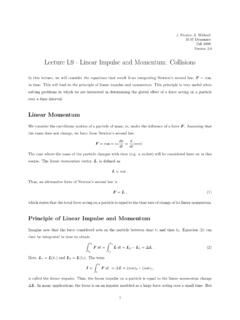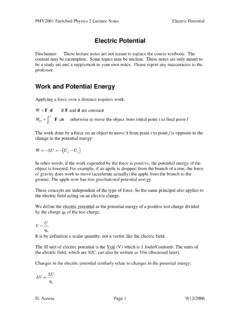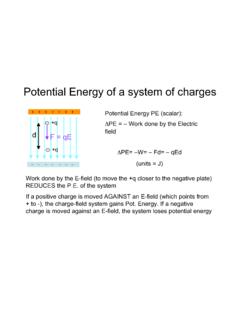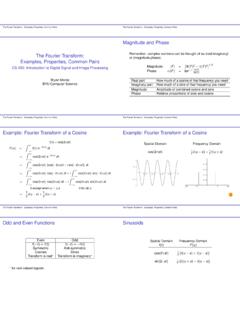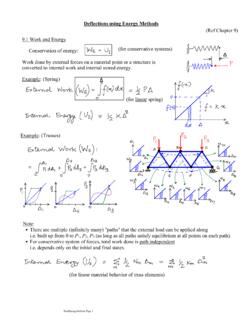Transcription of 19 LINEAR QUADRATIC REGULATOR - MIT OpenCourseWare
1 19 LINEAR QUADRATIC REGULATOR Introduction The simple form of loopshaping in scalar systems does not extend directly to multivariable (MIMO) plants, which are characterized by transfer matrices instead of transfer functions. The notion of optimality is closely tied to MIMO control system design. Optimal controllers, , controllers that are the best possible, according to some figure of merit, turn out to generate only stabilizing controllers for MIMO plants. In this sense, optimal control solutions provide an automated design procedure we have only to decide what figure of merit to use.
2 The LINEAR QUADRATIC REGULATOR (LQR) is a well-known design technique that provides practical feedback gains. (Continued on next page) Full-State Feedback 93 Full-State Feedback For the derivation of the LINEAR QUADRATIC REGULATOR , we assume the plant to be written in state-space form x = Ax + Bu, and that all of the n states x are available for the controller. The feedback gain is a matrix K, implemented as u = K(x xdesired). The system dynamics are then written as: x = (A BK)x + BKxdesired.
3 (210) xdesired represents the vector of desired states, and serves as the external input to the closed-loop system. The A-matrix of the closed loop system is (A BK), and the B-matrix of the closed-loop system is BK. The closed-loop system has exactly as many outputs as inputs: n. The column dimension of B equals the number of channels available in u, and must match the row dimension of K. Pole-placement is the process of placing the poles of (A BK) in stable, suitably-damped locations in the complex plane.
4 The Maximum Principle First we develop a general procedure for solving optimal control problems, using the calculus of variations. We begin with the statement of the problem for a fixed end time tf : tf choose u(t) to minimize J = (x(tf )) + L(x(t), u(t), t)dt (211) to subject to x = f(x(t), u(t), t) (212) x(to) = xo (213) where (x(tf ), tf ) is the terminal cost; the total cost J is a sum of the terminal cost and an integral along the way. We assume that L(x(t), u(t), t) is nonnegative. The first step is to augment the cost using the costate vector (t).
5 Tf J = (x(tf )) + (L + T (f x ))dt (214) to Clearly, (t) can be anything we choose, since it multiplies f x = 0. Along the optimum trajectory, variations in J and hence J should vanish. This follows from the fact that J is chosen to be continuous in x, u, and t. We write the variation as J = x x(tf ) + tf Lx x + Lu u + T fx x + T fu u T x dt, (215) to where subscripts denote partial derivatives. The last term above can be evaluated using integration by parts as tf tf xdt = T (tf ) x(tf ) + T (to) x(to) + T xdt, (216) to T to and thus 94 19 LINEAR QUADRATIC REGULATOR tf J = x(x(tf )) x(tf ) + (Lu + T fu) udt + (217) to tf (Lx + T fx + T ) xdt T (tf ) x(tf ) + T (to) x(to).
6 To Now the last term is zero, since we cannot vary the initial condition of the state by changing something later in time - it is a fixed value. This way of writing J makes it clear that there are three components of the variation that must independently be zero (since we can vary any of x, u, or x(tf )): Lu + T fu = 0 (218) Lx + T fx + T = 0 (219) x(x(tf )) T (tf ) = 0. (220) The second and third requirements are met by explicitly setting T = Lx T fx (221) T (tf ) = x(x(tf )). (222) The evolution of is given in reverse time, from a final state to the initial.
7 Hence we see the primary difficulty of solving optimal control problems: the state propogates forward in time, while the costate propogates backward. The state and costate are coordinated through the above equations. Gradient Method Solution for the General Case Numerical solutions to the general problem are iterative, and the simplest approach is the gradient method. It is outlined as follows: 1. For a given xo, pick a control history u(t). 2. Propogate x = f(x, u, t) forward in time to create a state trajectory.
8 3. Evaluate x(x(tf )), and the propogate the costate backward in time from tf to to, using Equation 221. 4. At each time step, choose u = K(Lu + T fu), where K is a positive scalar or a positive definite matrix in the case of multiple input channels. 5. Let u = u + u. 6. Go back to step 2 and repeat loop until solution has converged. LQR Solution 95 The first three steps are consistent in the sense that x is computed directly from x(to and u, and is computed directly from x and x(tf ). All of J in Equation 217 except the integral with u is therefore eliminated explicitly.)
9 The choice of u in step 4 then achieves J < 0, unless u = 0, in which case the problem is solved. The gradient method is quite popular in applications and for complex problems may be the only way to effectively develop a solution. The major difficulties are computational expense, and the requirement of having a reasonable control trajectory to begin. LQR Solution In the case of the LINEAR QUADRATIC REGULATOR (with zero terminal cost), we set = 0, and 1 L =1 x T Qx + u T Ru, (223)2 2 where the requirement that L 0 implies that both Q and R are positive definite.
10 In the case of LINEAR plant dynamics also, we have Lx = x T Q (224) Lu = u T R (225) fx = A (226) fu = B, (227) so that x = Ax + Bu (228) x(to) = xo (229) = Qx AT (230) (tf ) = 0 (231) Ru + BT = 0. (232) Since the systems are clearly LINEAR , we try a connection = P x. Inserting this into the equation, and then using the x equation, and a substitution for u, we obtain P Ax + AT P x + Qx P BR 1BT P x + P = 0. (233) This has to hold for all x, so in fact it is a matrix equation, the matrix Riccati equation.











